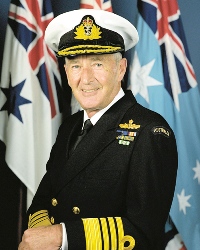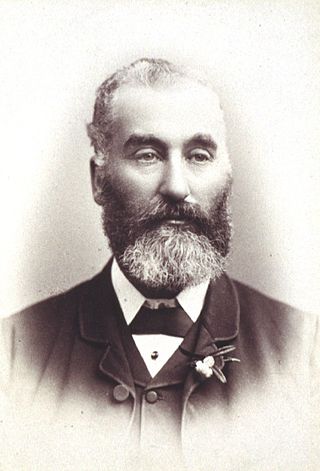Related Research Articles

Major General Philip Michael Jeffery, was a senior Australian Army officer and vice-regal representative. He was the 28th governor of Western Australia from 1993 to 2000, and the 24th governor-general of Australia, serving from 2003 to 2008.
Lieutenant General John Murray Sanderson, is a retired senior Australian Army officer and vice-regal representative. He served as Force Commander of the United Nations Transitional Authority in Cambodia from 1992 to 1993, Chief of Army from 1995 to 1998, and was the 29th Governor of Western Australia from 2000 to 2005.

General Sir Peter John Cosgrove, is an Australian retired senior Army officer who served as the 26th governor-general of Australia, in office from 2014 to 2019.

Lieutenant General Sir Donald Beaumont Dunstan was an Australian Army officer who was Governor of South Australia from 23 April 1982 until 5 February 1991. A career officer, after joining the Army in 1940 during the Second World War, Dunstan graduated from the Royal Military College, Duntroon in 1942 and served as an infantry officer, seeing combat against the Japanese during the Bougainville Campaign in 1945. After the war, he served in a variety of appointments, including as commander of the 1st Australian Task Force during the Vietnam War. From 1977 to 1982 he held the appointment of Chief of the General Staff, before retiring from the Army having overseen a large-scale re-organisation. Afterwards, he became the longest-serving governor of South Australia. He died in 2011, at the age of 88.

General Sir Phillip Harvey Bennett, was a senior officer of the Australian Army who served as Chief of the Australian Defence Force from 1984 to 1987, and later as Governor of Tasmania from 1987 to 1995.

General Sir Francis George Hassett, was an Australian general who rose to the position of Chief of the Defence Force Staff, the professional head of the Australian Defence Force, serving in this capacity from November 1975 until April 1977. Hassett joined the Australian Army in 1935 upon gaining entrance into the Royal Military College, Duntroon. Serving with distinction in the early stages of the Second World War, he was promoted to lieutenant colonel in 1942 at the age of 23, and posted as a staff officer for the remainder of the war.

Lieutenant General Peter Francis Leahy, is a retired senior officer of the Australian Army, whose military career culminated with his appointment as Chief of the Army from 2002 until 2008. He has been director of the National Security Institute, University of Canberra, since October 2008.

Arthur Edmon Brown Jr. is a retired four-star general of the United States Army who served as Vice Chief of Staff (VCSA) from 1987 to 1989.

Lieutenant General Sir Reginald George Pollard, was a senior commander in the Australian Army. He served as Chief of the General Staff from 1960 to 1963.

Admiral Alan Lee Beaumont, was a senior officer in the Royal Australian Navy, whose career culminated with his appointment as Chief of the Defence Force from 1993 to 1995.

Admiral Michael Wyndham "Mike" Hudson was a senior officer in the Royal Australian Navy (RAN), particularly notable for playing an important role in the introduction of the Collins class submarines and Anzac Class frigates, and establishing two-ocean basing for ships of the RAN during his tenure as Chief of Naval Staff from 1985 to 1991.
General Peter Courtney Gration is a retired senior Australian Army officer who served in the positions of Chief of the General Staff (1984–87) and Chief of the Defence Force (1987–93), the professional head of the Australian Army and Australian Defence Force, respectively.

General Sir Arthur Leslie MacDonald, was a senior officer in the Australian Army, who served in the positions of Chief of the General Staff from 1975 to 1977, then Chief of the Defence Force Staff from 1977 to 1979; the professional head of the Australian Army and Australian Defence Force respectively.
Lieutenant General John Cedric Grey AC was a senior officer in the Australian Army who served as Chief of the General Staff from 1992 to 1995. He was Chancellor of James Cook University from 1999 to 2016.

Lieutenant General Henry John Coates, was a senior officer in the Australian Army who served as Chief of the General Staff from 1990 to 1992. After retiring from the army, he became an author and a visiting fellow at the Australian Defence Force Academy branch of the University of New South Wales, pursuing aspects of Australia's military history.

Sir John George Davies, generally known as (Sir) George Davies, was a Tasmanian politician, newspaper proprietor and first-class cricketer.
Colonel Sir Charles Edward Merrett CBE was an Australian merchant, agriculturist and political activist.

Vice Admiral Ian Warren Knox, was a senior officer of the Royal Australian Navy (RAN). In a 42-year career, Knox commanded HMA Ships Torrens, Hobart and Melbourne, briefly served as Deputy Chief of Naval Staff, and was Flag Officer Commanding HM Australian Fleet from 1985 to 1987. His career culminated with his appointment as Vice Chief of the Defence Force in January 1987; a position he held until his retirement in September 1989.

Lieutenant General Donald Stuart McIver, was a New Zealand military officer who was the Chief of the General Staff (1987–1989) and the director of the New Zealand Security Intelligence Service (1991–1999).
Major General John Curtis Hartley, is an Australian defence and intelligence strategist and a retired officer of the Australian Army. He joined the army via the Royal Military College, Duntroon in 1962, was commissioned into the Royal Australian Infantry Corps and spent much of his career in military intelligence. He twice deployed on operations during the Vietnam War, during which he was Mentioned in Despatches on two occasions and seriously wounded, and commanded the Albury–Wodonga Military Area and the Army Apprentices' School (1984–87). He served as General Officer Commanding Training Command (1991–92), Director of the Defence Intelligence Organisation (1992–95), Deputy Chief of Army (1995–98), and Land Commander Australia (1998–00). Since his retirement from the army in 2000, Hartley has been involved in community and veterans' organisations and is an active contributor to discussion on defence and strategic issues.
References
- ↑ "The NRAA President". NRAA History. National Rifle Association of Australia. 24 May 2022. Archived from the original on 10 August 2022. Retrieved 10 March 2023.
- ↑ Interview by Colonel David Chinn MBE (Rtd) Archived 5 September 2012 at the Wayback Machine Australian War Memorial
- ↑ Lawrence George O'DONNELL Nominal Roll of Vietnam Veterans, www.vietnamroll.gov.au
- ↑ Companion of the Order of Australia, 12 June 1989, It's an Honour
- ↑ "Immigration Bridge Australia". Archived from the original on 18 April 2010. Retrieved 17 April 2010.
- ↑ "Kolapore Results - 2000-Present" (PDF). National Rifle Association. Archived (PDF) from the original on 16 January 2021. Retrieved 10 March 2023.